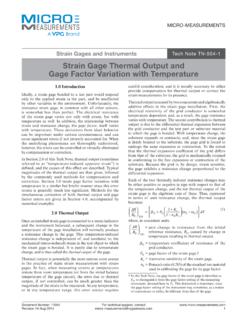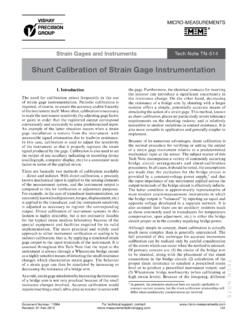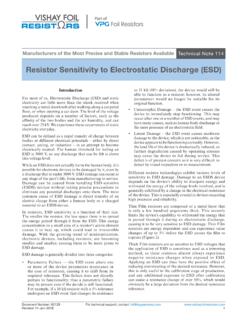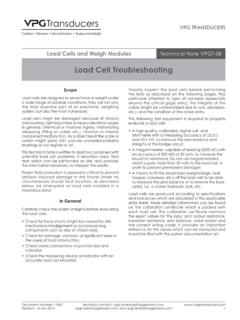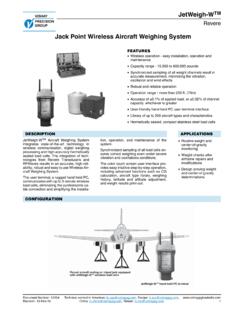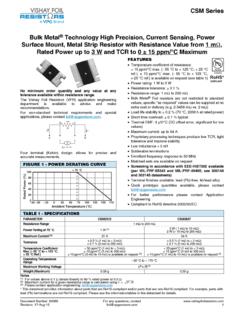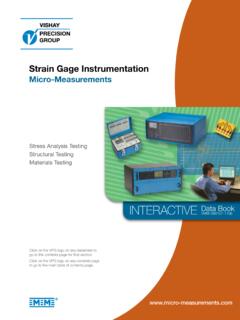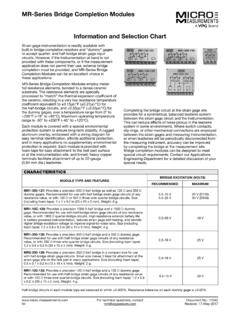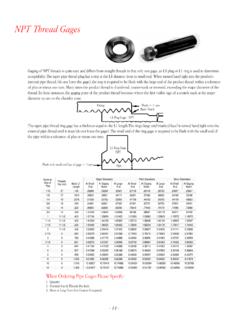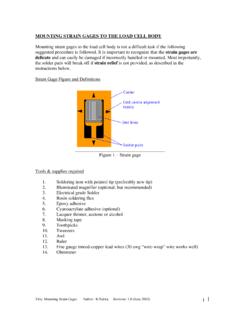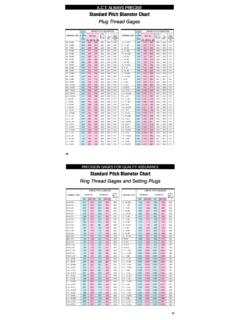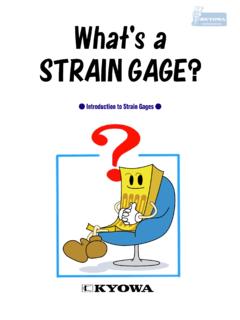Transcription of Fatigue Characteristics of Micro-Measurements Strain Gages
1 Tech Note TN-508-1 micro -MeasureMeNTsFatigue Characteristics of Micro-Measurements Strain GagesTech NoTeStrain Gages and InstrumentsFor technical support, contact Number: 11058revision: 01-Nov-2010 All metals are subject to Fatigue damage when strained cy cli cally at sufficiently high amplitudes; and the foils used in Strain Gages are no exception. Fatigue damage in a Strain gage is first evidenced as a permanent change in unstrained resistance of the gage , ordinarily expressed in terms of equivalent indicated Strain , and referred to as zero-shift . As damage increases in Strain Gages , cracks eventually begin to develop and these can result in data that is seriously in monitors three parameters of Strain Gages during Fatigue life testing: super-sensitivity , gage factor change, and zero-shift.
2 Super-sensitivity results from cracks that are just forming, and that are open only during the tension portion of the loading cycle. If output of a Strain gage is monitored continuously on an oscilloscope during a Fatigue test, the waveform observed for an undamaged gage will be a sine wave. As cracking starts, the sine wave will distort during the tension portion of the cycle. Monitoring for onset of cracking is necessary because, at zero load, cracks often close and their presence can be hidden. Experimental stress analysts who unexpectedly encounter large Strain signals from Strain Gages in cyclic applications should check signal waveform for any indications of damage in Strain Gages can also cause gage factor changes, although substantial differences are rare.
3 If cracking has started, however, it will cause an apparent increase in tension gage factor, easily detected because the compression value will be much for Fatigue testing of Micro-Measurements Gages start with the very best installations that can be made (see Appendix A). No Strain gage application requirement is more demanding than cyclic endurance. Micro-Measurements uses NAS-942 test rigs with modified beams to achieve Strain levels of different magnitudes*. Zero of each gage is recorded along with output for both tension and compression static strains of the same magnitude as will be encountered during cycling. Throughout dynamic loading, gage outputs are monitored for Gages can be considered to fail over a wide range of damage levels, depending on the application and the required accuracy.
4 For example, in static/dynamic Strain measurement , varying with the particular situation, there is some level of damage at which zero-shifts may impair the utility of Strain Gages for that application. Such zero-shifts thus represent failure under those conditions, even though the Strain Gages could still endure many thousands or millions of additional cycles before Fatigue cracks became evident. On the other hand, for purely dynamic Strain measurement zero-shift is relatively incidental, and Strain Gages can be considered functionally adequate until Fatigue damage has progressed almost to the stage of behavior of Strain Gages is illustrated by the following graphs in Figure 1 of data from WK-05-250BG-350 Gages . Note that as the Strain level is reduced, and life extended, the spread in data increases markedly.
5 Prediction of gage life in high cycle Fatigue (over 5 x 105 cycles) is difficult because the test data displays large variations. Using the data in Figure 1, a nominal Fatigue life curve can be drawn for WK-05-250BG-350 Gages as shown in Figure 2, based on a 100 zero-shift failure criterion. Other typical data are shown in Appendix 1 is a summary of the Fatigue Characteristics of Micro-Measurements Strain Gages . Fatigue Life in the table generally refers to the approximate number of cycles at which a zero-shift of 100 can be expected. WD Gages , normally used only for dynamic testing, have values for a 300 zero-shift (approximately).The data in Table 1 and graphs in Appendix B were obtained using 1/4-in [ ] gage length Strain Gages .
6 gage selection is an important criterion in achieving maximum cyclic life and many different parameters affect the endurance of Strain Gages . A study of Table 1 will provide information on how the different series (backing/alloy combinations) relate to each other in Fatigue life. In addition, a number of other criteria have marked effects and each compromise made deteriorates life to some degree. While there are many aspects to selection of appropriate Gages for any application, there are some general rules concerning what will improve or deteriorate Fatigue life. (Refer to Micro-Measurements Tech Note TN-505, Strain gage Selec tion Criteria, Procedures, Recommendations.) The larger the grid area of foil Strain gage , the higher its Fatigue life; but, the higher the gage s resistance, the lower its Fatigue life.
7 * The NAS-942 beam is designed for constant stress, producing a single 1500 Strain NoTeFor technical questions, Number: 11058revision: Characteristics of Micro-Measurements Strain GagesEncap sulation (such as E or SE on E-backed Gages ) is helpful while solder and copper have a negative effect; so CEA-Series Gages or Gages with Options L, LE, or W on EA-Series Gages should be used with caution. Some very small Micro-Measurements Gages , and some very high resistance Gages , are made using ultra-thin foil. These Gages should be avoided where cyclic endurance is important. While such Gages can t be identified from catalogs, estimated Fatigue life for any Micro-Measurements Gages can be obtained from our Applications Engi neering Depart 2 average cyclic endurance of WK Strain 1 Strain gage Fatigue test NoTeFor technical questions, Number: 11058revision.
8 Characteristics of Micro-Measurements Strain GagesTable 1 Nominal Fatigue Life 100 Zero-ShiftM-MGage SeriesStrain Level, Numberof CyclesM-MGage SeriesStrain Level, Number ofCyclesCEA 1500 1300105106SA 1800 1500106107EA 1500 1200106108SK 2200 2000106107ED 2500 2200106107S2K 1800 1500106107EK 1800 1500107108SD 2500 2200106108EP 1500 1000102104TA 1700 1500106107J2A 1700 1500106107TK 2200 2000107108J5K 2000 1800107108TD 2400107N2A 1700 1500106107WA 1800 1500106107N2K 1800 1500107108WK 2400 2200106107N3K 1500108WD 3000 2500105*107**300 zero-shift (approximately) for WD Strain above Fatigue life data is based on fully reversed Strain levels. as a generalized approximation, this table can be used for unidirectional strains, or various mean-strains, by taking the indicated peak-to-peak amplitude and derating by 10 percent.
9 As an example, 1500 would be approximately equivalent in gage Fatigue damage to Strain levels of +2700 0 +2500 0 2700 200 a mean- Strain which increases in a tensile direction during cycling will lead to much earlier failure, Strain Gages , Bonded Resistance , Classification Specification NAS-942 (National Aerospace Standard 942) 1963. Aerospace Industries Association of America, Inc. Published by National Standards Association, Inc., 1200 Quince Orchard Boulevard, Gaithersburg, MD NoTeFor technical questions, Number: 11058revision: Characteristics of Micro-Measurements Strain GagesWhen designing structures for maximum Fatigue endurance, special care should be employed to avoid rapid changes in section, stress concentrations, and excess inertial loading, to name a few considerations.
10 When stress concentrations are unavoidable, they should be in a minimum Strain field. The same considerations apply to Strain gage installations in a Fatigue , bonding agents used to adhere Gages should be unfilled, thin-film-setting adhesives such as M-Bond 200, M-Bond 600 or 610, or M-Bond AE-10 or AE-15. All excess adhesive around the edge of Gages should be removed to prevent this unnecessarily thick film of cement from cracking and initiating failure of the gage connections present the greatest stress concentrat ions at the gage location. Solder is poor in Fatigue and, therefore, must be applied sparingly. Controlling solder flow on gage tabs can be accomplished by carefully masking the tab with drafting tape.
